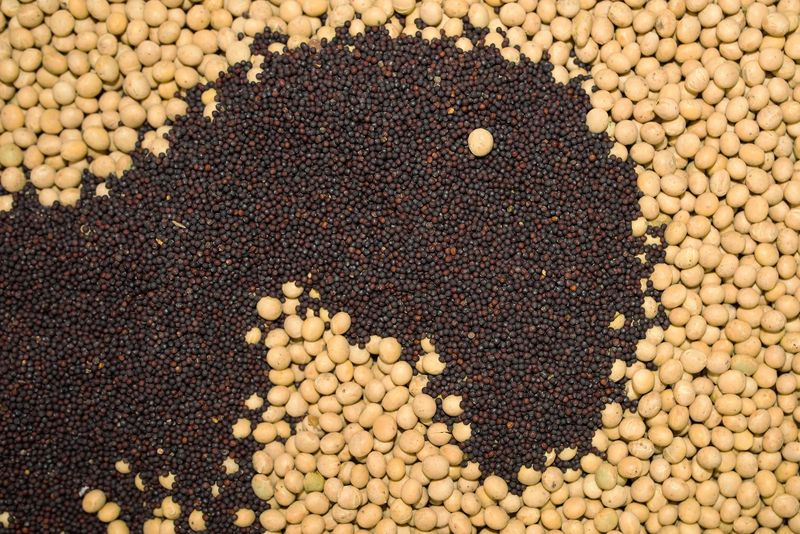Rapeseed-soybean imbalance: at what cost Ukrainian farmers were forced to help processors
21 November 16:42
Ukrainian rapeseed oil producers have a reason to talk about historic achievements. The introduction of the export tax has helped to increase the utilization of processing plants and boost exports of this product abroad. But did the farmers who grew this rapeseed lose out? The answer to this question was found in
“We are looking for a balance between the farmer’s margin and the utilization of factories,” said Vitaliy Koval, then Minister of Agrarian Policy, in early June this year, speaking about the possible introduction of export duties and the corresponding restriction on soybean and rapeseed exports.
Three months later, the relevant law, and the export duties, came into force.
However, it was not without problems and additional headaches for farmers, who had to wait for another month for the government to approve a mechanism to exempt products grown by farmers themselves from export duties. This uncertainty affected not only soybean and rapeseed exports, which were negatively affected, but also processing, which was positively affected.
At least in early November, Economy Minister Oleksiy Sobolev announced a significant increase in shipments of rapeseed oil abroad: exports of this product increased by 350% compared to August.
“This made it possible to shift the focus from raw material exports to highly processed products, which allows Ukrainian producers to increase added value,” the Minister emphasized.
In September 2025, following the introduction of the export duty on rapeseed, processing increased to 250 thsd tonnes, the highest monthly figure ever. According to the Ukroliyaprom Association, 120 thousand tons of rapeseed oil were produced in September, of which 108.8 thousand tons were exported.
In search of balance
Did Ukrainian officials manage to find a balance between the interests of farmers who grow soybeans and rapeseed and want to export their products and processors who want to load their plants with these products? And how did this balancing act affect prices?
Oleksandr Buyukli, executive director of the First Ukrainian Agricultural Cooperative, answers these questions:
“The situation is such that as soon as it was reported that the President signed the soybean and rapeseed amendments in early September, prices for these crops immediately went down. If you look at the processing margin, it is the highest for soybeans, followed by rapeseed, and sunflower is in the last place. And it is precisely because of these duties that processors get a significant price advantage. Many producers of both rapeseed and soybeans are currently losing about UAH 2000 per ton,” the expert says.
Mr. Buiukli also spoke about the current situation with soybean production, processing and exports, and whether there is really competition for soybeans between processors and exporters:
“The weather was unstable for almost the entire period. In the spring, the temperature changed very sharply, which delayed the plant’s vegetation. And since mid-September, it has been raining, and up to 5-7% of soybeans will not be harvested. Production will drop to about 5 million tons, which is 1-1.2 million tons less than in previous years. As the harvesting campaign in Ukraine has been delayed and supply has decreased overall, this has affected prices and increased competition. As for exports, despite the high demand from importers, soybean exports are low. For your understanding: in October last year, 675 thsd tonnes were exported, this October – 235 thsd tonnes. Processing, on the other hand, is at record levels. The first two months of the season showed 528 thsd tonnes of soybean processing, last year – 347 thsd tonnes,” the expert said.
According to the executive director of the cooperative, the situation with rapeseed is no less complicated:
“Rapeseed is often quick money for farmers. It is harvested in July and August and sold almost immediately. Due to export duties, more than 1 million tons are still in stock in Ukraine. Quite a significant area under the oilseed was lost due to the weather. According to our estimates, about 3 mln tons were harvested. The situation with exports is the same as with soybeans – they are weak and 2-3 times lower than last year. Unfortunately, the 10% duty makes prices in ports uncompetitive. We estimate that in the current season, up to 2.5 mln tons will be exported (minus 0.5 mln tons compared to the last season), and up to 3 mln tons will be processed,” the expert said.
Not only rapeseed oil
In 2024, the value of sales of processed products in foreign markets exceeded USD 4 billion, recovering to the levels of 2021, and this amounted to almost 17% of the commodity structure of Ukraine’s agri-food exports. In the first 10 months of this year, a total of about USD 3.6 billion worth of such products were exported, and their share has now increased to 19.5%.
“For 10 months of 2025, the export of sunflower oil amounted to 3560 thousand tons worth 4.2 billion dollars, soybean oil – 464 thousand tons worth 488 million dollars, rapeseed oil – 247 thousand tons worth 275 million dollars. Also, the country exported 1291 thousand tons of soybean oil residues worth $421 million, and other oil residues, including sunflower oil – 2695 thousand tons worth $621 million. In January-October 2025, exports of finished grain products produced in Ukraine (USD 409 million), sugar and confectionery (USD 380 million), beverages (USD 314 million), chocolate and other cocoa products (USD 278 million), processed fruits and vegetables (USD 274 million), butter (USD 97 million), and powdered and condensed milk (USD 79 million) also attracted attention,” the expert said.
Thus, it can be concluded that Ukrainian companies offer a fairly wide range of processed food products on the international market.
At the same time, the potential of their production and export is still not fully utilized.
Author: Sergiy Vasilevich









